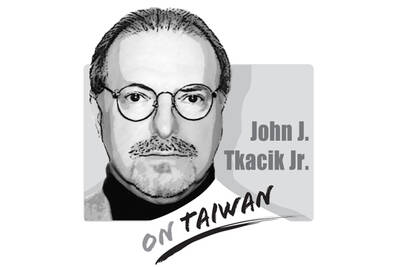Many in Taiwan were appalled by the news that a statue honoring Japanese engineer Yoichi Hatta in Tainan was found decapitated early on Sunday morning.
China Unification Promotion Party member and former Taipei city councilor Lee Cheng-lung (李承龍) yesterday turned himself in and confessed that he and a female accomplice were responsible for the vandalism.
Some commentators, pointing to previous cases of vandalism to statues of Chiang Kai-shek (蔣介石), asked whether the Hatta statue was targeted by anti-Japan or pro-unification supporters in a bid to take “a head for a head.”
Any form of vandalism or hateful act ought to be condemned, irrespective of the national or political identity that inspires it.
However, to equate the philosophy behind the erection of the Hatta statue with what led to the proliferation of Chiang statues around the nation is a serious error.
In addition, anyone trying to criticize Taiwan’s honoring of a Japanese as an act of “Japanization” that fawns on the nation’s past colonial rulers has failed to understand history and is interested only in inciting ethnic conflict.
To examine Hatta and Chiang from a purely historical standpoint, the two are worlds apart: Hatta never killed anybody. Chiang, on the other hand, was perceived by many Taiwanese as a murderer responsible for the bloody 228 Incident during which thousands of Taiwanese and Mainlanders perished; Hatta contributed to Taiwan with his planning and overseeing of the construction of Tainan’s Wushantou Reservoir (烏山頭水庫), whose irrigation network benefited the farmers of the Chianan Plain (嘉南平原); Chiang’s Chinese Nationalist Party (KMT) took over properties belonging to the former colonial government and private properties as party assets when the Japanese colonial government and settlers left Taiwan in 1945.
It is also worth noting that Hatta’s statue came about as a result of a public initiative; it was built and financed by his subordinates, whereas the countless Chiang statues around Taiwan were erected using taxpayers’ money and without the public’s consent.
A critic might say that Hatta’s construction of the Wushantou Reservoir was motivated by the then-colonial government’s concern over a stable rice supply. However, that Hatta’s engineering achievements helped lay the keystone of Taiwan’s modernization is indisputable.
Hatta, dubbed by Taiwanese as the “Father of the Chianan Irrigation System,” is remembered not only because of the reservoir — which dramatically increased the annual production of crops in the 150,000 hectare Chianan Plain which spans from Tainan through Yunlin and Chiayi counties and greatly improved the lives of tens of thousands of households in the region — but also because despite being an official of the colonial government, he showed humility toward the welfare of Taiwanese and did not oppress or exploit them as other colonial officials did.
The values behind the statues of the two are strikingly different: Hatta was apolitical and he earned the respect of Taiwanese via his selfless deeds; Chiang’s statues were erected to idolize the leader of a totalitarian regime.

“Si ambulat loquitur tetrissitatque sicut anas, anas est” is, in customary international law, the three-part test of anatine ambulation, articulation and tetrissitation. And it is essential to Taiwan’s existence. Apocryphally, it can be traced as far back as Suetonius (蘇埃托尼烏斯) in late first-century Rome. Alas, Suetonius was only talking about ducks (anas). But this self-evident principle was codified as a four-part test at the Montevideo Convention in 1934, to which the United States is a party. Article One: “The state as a person of international law should possess the following qualifications: a) a permanent population; b) a defined territory; c) government;
The central bank and the US Department of the Treasury on Friday issued a joint statement that both sides agreed to avoid currency manipulation and the use of exchange rates to gain a competitive advantage, and would only intervene in foreign-exchange markets to combat excess volatility and disorderly movements. The central bank also agreed to disclose its foreign-exchange intervention amounts quarterly rather than every six months, starting from next month. It emphasized that the joint statement is unrelated to tariff negotiations between Taipei and Washington, and that the US never requested the appreciation of the New Taiwan dollar during the
Since leaving office last year, former president Tsai Ing-wen (蔡英文) has been journeying across continents. Her ability to connect with international audiences and foster goodwill toward her country continues to enhance understanding of Taiwan. It is possible because she can now walk through doors in Europe that are closed to President William Lai (賴清德). Tsai last week gave a speech at the Berlin Freedom Conference, where, standing in front of civil society leaders, human rights advocates and political and business figures, she highlighted Taiwan’s indispensable global role and shared its experience as a model for democratic resilience against cognitive warfare and
The diplomatic spat between China and Japan over comments Japanese Prime Minister Sanae Takaichi made on Nov. 7 continues to worsen. Beijing is angry about Takaichi’s remarks that military force used against Taiwan by the Chinese People’s Liberation Army (PLA) could constitute a “survival-threatening situation” necessitating the involvement of the Japanese Self-Defense Forces. Rather than trying to reduce tensions, Beijing is looking to leverage the situation to its advantage in action and rhetoric. On Saturday last week, four armed China Coast Guard vessels sailed around the Japanese-controlled Diaoyutai Islands (釣魚台), known to Japan as the Senkakus. On Friday, in what